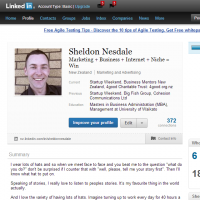 (Missed part 1? Read it first)
(Missed part 1? Read it first)
Firstly, it’s important to note that “100% completion” is your starting point.
That’s right, spend a few hours and just get all the basics done and out of the way until you score 100% completion.
Then come back here and read the rest of this article.
The 8 Most Important Components (or “Cows”) of LinkedIn For You To Milk
1. Customise your profile address url
- The default is nasty
- You can have LinkedIn.com/firstname.surname which is much nicer for your email signature and business cards
- For example, mine is: http://nz.linkedin.com/in/sheldonnesdale
2. Join at least 10 groups
- Join a set of groups that paint a picture of your interests
- Include several dedicated to your city, several to your country, and a few international ones
- Don’t bother reading the discussions in those groups. Don’t bother starting discussions yourself. Just join to get the “badges” on your profile
3. Be creative with your job titles
- Have some fun with them
- Poke fun at yourself
- Be a little outrageous
- I’ve created a website that lists all of New Zealand hot pools so my job title for that is “Head Hot Hydro Honcho”.
- Stupid? Yes. Silly? Yes. Entertaining and different that might brighten someones day even for a moment? Yes.
4. Be creative with your job descriptions
- Use numbers to made things concrete Eg “Developed 47 business plans, created 53 advertising plans, wrote 54,327 words for newspaper ads”
- Take a guess at the numbers rather than painstakingly count, and don’t round them off
- The longer ago a role was for you, the more you should simplify your experience there to a single project, or the biggest impact you made, or a long lasting improvement you made. Tell a story
- Say something controversial
- Take a stand on an issue
- Wake people up
- For example, in one of my roles I say “When clients come to me for a new website, I don’t give a damn about what they want, I only care about what THEIR customers want.”
- The worst you can do is be boring. The world is full of boring. Don’t add to it.
5. Write your summary last
- Weave together elements of your past, your attitude in the present, and your plans and ambitions for your future
6. Be the first to connect
- Every time you meet someone face-to-face (or talk to them for a reasonable time over the phone), find them on LinkedIn and request a connection
- Do not use the default message which is “I’d like to connect with you”. It requires zero effort and everyone knows it, so it cheapens your effort to connect and looks like spam
- You could make a reference to how you met, repeat something they said to you, or thank them for a specific piece of advice or an idea they had, or simply say “Hi firstname!“
7. Don’t add people you don’t know
- If you get requests from people you don’t know, don’t add them
- They are just playing a game to get more connections than other people
- And worse than that, by adding them you are “vouching for them” and they may use your endorsement to get to others in your network. Not cool
8. Write recommendations for people you want recommendations from
- Testimonials/recommendations are powerful stuff. They help people trust you and get to know you
- It’s easy to get them, just write them for others and that creates pressure to reciprocate without you even asking
- I’m not a big fan of pushing the “ask for a recommendation” button, but do it if things are moving too slow for you in this area
For bonus points (or bonus milk)
There are a few bonus sections that are a little hidden in the navigation that you could try. Like “Projects” and endorsing “Skills”.
For bonus points you could start discussions in the Groups you join (I might write a whole blog article just on that one day). A few ideas to start with:
- Write an engaging headline. Headlines that ask questions are the best
- Make it short. Articles on LinkedIn are more about generating discussion than you sharing your wisdom
- Finish the article by asking people to add their opinion or share their point of view
Do You Use LinkedIn?
- Did you find this article useful? Say so in the comments below
- Got value out of other sections I haven’t mentioned? Like the jobs section? Write your ideas in the comments below
